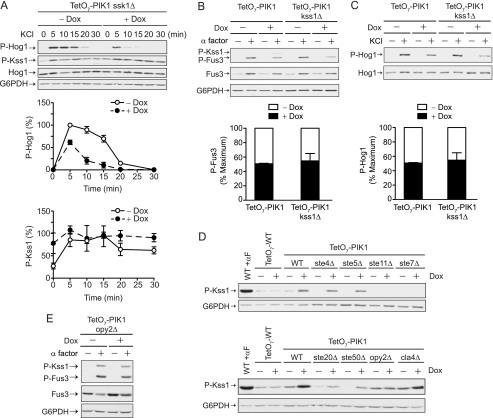FIGURE 6.
Pik1 acts via Ste11. A, TetO7-PIK1 ssk1Δ cells were treated with doxycycline (Dox) for 15 h and 0.5 m KCl for the times indicated and analyzed by immunoblotting with phospho-p38 (P-Hog1) antibodies, phospho-p44/42 (P-Kss1) antibodies, Hog1 antibodies, or G6PDH antibodies as a loading control. B, TetO7-PIK1 and TetO7-PIK1 kss1Δ cells were treated with doxycycline for 15 h and 3 μm α factor pheromone for 30 min, as indicated. Immunoblots were analyzed with phospho-p44/42, Fus3, and G6PDH antibodies. C, TetO7-PIK1 and TetO7-PIK1 kss1Δ cells were treated with doxycycline for 15 h and 0.5 Μ KCl for 10 min. Immunoblots were analyzed with phospho-p38 and G6PDH antibodies. D, Wild-type, TetO7-PIK1, and isogenic cells carrying ste4Δ, ste5Δ, ste11Δ, ste7Δ, ste20Δ, ste50Δ, opy2Δ, or cla4Δ mutations were treated with doxycycline for 15 h and α factor (αF) for 30 min and analyzed with phospho-p44/42 antibodies (P-Kss1). E, TetO7-PIK1 opy2Δ cells were treated as in B. All bands were quantified by scanning densitometry and analyzed with ImageJ software. Results are the mean ± S.E. for three individual experiments.

